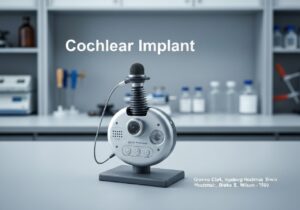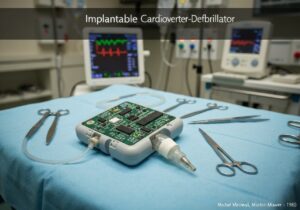Neural engineering is a field where neuroscience meets engineering. It aims to create technologies that communicate or improve brain function. By combining biology, computer science, and electrical engineering, it allows us to connect with the brain. This helps in finding new ways to diagnose and treat brain issues.
تشهد قطاعات مثل أجهزة الدماغ وواجهات الدماغ والحاسوب نمواً سريعاً. ويأتي هذا النمو من زيادة عدد كبار السن والإجراءات الطبية الأحدث والأسهل. تقدم جامعة إلينوي أوربانا شامبين بجامعة إلينوي أوربانا شامبين حديثاً عبر الإنترنت للطلاب الجدد. وهو يغطي الهندسة الحيوية والهندسة العصبية وعلوم الحاسوب والهندسة الحيوية. يسلط الحديث الضوء على كيفية تغيير تكنولوجيا الدماغ والتفاعل في مجال الرعاية الصحية.
النقاط الرئيسية
- تدمج الهندسة العصبية بين علم الأعصاب والهندسة لتطوير تقنيات تعزيز الدماغ.
- تؤدي زيادة الطلب على الأجهزة العصبية والإجراءات طفيفة التوغل إلى زيادة نمو الصناعة.
- تركز جامعة إلينوي أوربانا شامبين على الهندسة العصبية في برامجها متعددة التخصصات.
- تعد واجهات الدماغ والحاسوب في طليعة التطورات في مجال الهندسة العصبية.
- تلعب الأنظمة العصبية دوراً هاماً في مستقبل التشخيص والعلاجات الطبية.
مقدمة في الهندسة العصبية
تعد الهندسة العصبية في طليعة الإنجازات الطبية الحيوية. فهي تجمع بين علم الأعصاب والهندسة. الهدف هو التفاعل مع الجهاز العصبي، وتحسين قدرات الإنسان وإصلاح المشاكل العصبية. معرفة أساسيات الهندسة العصبية هو المفتاح لفهم تأثيرها الكبير على الطب والتكنولوجيا.
إن دماغ الإنسان معقد، حيث يزن حوالي ثلاثة أرطال ويضم حوالي 86 مليار خلية عصبية، بالإضافة إلى العديد من الخلايا الدبقية. هذه الشبكة ضرورية للإدراك، وهو ما تسعى الهندسة العصبية إلى تعزيزه. إن مقدمة في الهندسة العصبية يوضح مبادئه الرائدة.
يحتوي دماغ الإنسان البالغ على حوالي 86 مليار خلية عصبية وتريليونات من المشابك العصبية، مما يجعله نقطة محورية للدراسة في الهندسة العصبية.
يبحث الخبراء في الهندسة العصبية أيضًا عن طرق لعلاج مشاكل الدماغ مثل السكتة الدماغية أو إصابة العمود الفقري أو الصرع. ويهدفون إلى تعزيز وظائف الدماغ مثل الذاكرة والانتباه. ولكن، يثير عملهم أسئلة خطيرة حول الخصوصية والأخلاقيات والآثار المترتبة على المجتمع.
أسس الهندسة العصبية
إن مجال الهندسة العصبية مجال رائع. فهو يربط بين جهازنا العصبي والأجهزة الاصطناعية. وهو يعتمد على الترميز العصبي, اللدونة التشابكيةو واجهات الدماغ والحاسوب (BCIs).
الترميز العصبي
الترميز العصبي عن كيفية استخدام الخلايا العصبية للنشاط الكهربائي لمعالجة المعلومات. وهو أمر حيوي لفهم كيفية تحدث الدماغ ومعالجته للإشارات. وقد اكتشف الباحثون كيف ترتبط الأنماط المختلفة بالأحاسيس أو الأفعال.
هذه المعرفة ضرورية لتطوير تقنية BCI. يساعد في جعل الأطراف الاصطناعية العصبية أكثر فعالية.
اللدونة المشبكية
اللدونة المشبكية يتيح للمشابك العصبية تغيير قوتها بناءً على النشاط. إنه مفتاح التعلم والذاكرة. ويتيح لداراتنا الدماغية أن تتحسن بمرور الوقت.
في الهندسة العصبية، يساعد هذا المفهوم في تحسين الشبكات الاصطناعية. كما أنه يجعل الأجهزة العصبية تعمل بشكل أفضل مع أجسامنا.
واجهات الدماغ والحاسوب (BCIs)

إن BCIs هي أدوات مذهلة تربط أدمغتنا مباشرة بالأجهزة. وهي تقوم بذلك عن طريق تحويل إشارات الدماغ إلى أوامر. وهذا يسمح للناس بالتحكم في أشياء مثل أجهزة الكمبيوتر أو الأطراف الصناعية بعقولهم.
هذه التقنية ستغير قواعد اللعبة بالنسبة للأشخاص الذين لا يستطيعون الحركة بسهولة. كما أنها تفتح طرقاً جديدة لتعزيز القدرات البشرية.
تمزج الهندسة العصبية بين المعرفة من العديد من المجالات مثل علم الأعصاب الحاسوبي والهندسة الكهربائية. إن خبرتنا المتنامية في الترميز العصبي, اللدونة التشابكيةو تقنية BCI تتيح لنا إنشاء جسور جديدة. تربط هذه الجسور أدمغتنا بعالم الأجهزة.
| الحقل | ركز | أمثلة |
|---|---|---|
| الترميز العصبي | تمثيل المعلومات في الخلايا العصبية | Deciphering sensory and motor signals |
| اللدونة المشبكية | التغيرات التكيفية في قوة المشبك العصبي | التعلم والذاكرة |
| واجهات الدماغ والحاسوب (BCIs) | التواصل المباشر بين الدماغ والجهاز | التحكم في الأطراف الاصطناعية والتقنيات المساعدة |
واجهات الدماغ والحاسوب: التواصل المباشر مع الدماغ
لقد غيرت واجهات الدماغ والحاسوب، أو BCIs، طريقة تفكيرنا في كيفية تحدث الدماغ مع الآلات. الآن، يمكن للأشخاص التحكم في أجهزة الكمبيوتر أو الأطراف الاصطناعية فقط باستخدام موجات الدماغ. تنقسم هذه الأدوات المذهلة إلى ثلاثة أنواع الواجهات بين الدماغ والحاسوب:: مؤشرات التواصل القاعدي القابل للتوغل غير الجراحي والجراحي والجراحي الباضع.
مؤشرات التواصل القاعدي القاعدي غير الباضع
تعمل مؤشرات BCI غير الباضعة بدون جراحة. فهي تستخدم مستشعرات خاصة من الخارج لالتقاط إشارات الدماغ. والتقنية الأكثر استخداماً هي تقنية تخطيط كهربية الدماغ EEG، التي تسجل الذبذبات الكهربائية للدماغ من فروة الرأس. حقق هانز بيرغر قفزة كبيرة في هذا المجال منذ 80 عاماً بدراسته لإيقاع ألفا.
ومنذ ذلك الحين، ظهرت اختراعات مثل جهاز التهجئة P300. وهي تتيح للمستخدمين اختيار الحروف على الشاشة بمجرد التفكير. يلعب تحليل إيقاع الدماغ وأنماط استجابته دوراً كبيراً في جعل هذه التقنيات تعمل.
مؤشرات قاع الباطنة الغازية
تتطلب مقياس تخطيط كهربية الدماغ الباضع وضع أقطاب كهربائية في الدماغ مباشرة. توفر هذه الطريقة إشارات أوضح ولكنها تنطوي على مخاطر. من خلال تدريب الدماغ، استخدم الباحثون هذه التقنية لإعطاء قدرات جديدة لمن يعانون من قيود جسدية خطيرة. منذ سبعينيات القرن الماضي، شهدنا تقدماً كبيراً، بما في ذلك استخدام إشارات الدماغ لتشغيل الأدوات.
مؤشرات قصور القلب القاعدي الباضع بالحد الأدنى من التدخل الجراحي
Minimally invasive BCIs are less harsh than fully invasive ones but offer better signals than noninvasive types. They use advanced techniques to place devices inside the brain with less risk. With these tools, people can do things like use a computer, send emails, or move robotic arms just by thinking.
| نوع BCI | الطرق/الأدوات | المزايا | العيوب |
|---|---|---|---|
| غير جراحي | تخطيط كهربية الدماغ | سهولة الاقتناء، بدون جراحة | وضوح إشارة أقل |
| الغازية | الأقطاب الكهربية الدقيقة، تخطيط كهربية القلب الكهربائي الكهربائي | وضوح إشارة عالية الوضوح | يتطلب جراحة، ومخاطر محتملة |
| التدخل الجراحي البسيط | الأقطاب الكهربائية المجسمة العميقة المجسمة والمصفوفات المجهرية داخل القشرة | التوازن بين الوضوح والتوغل | أقل رسوخًا من الطرق الأخرى |
تقنيات التحفيز العصبي
لقد غيرت تقنيات التحفيز العصبي طريقة علاجنا للمشاكل العصبية. فهي تجلب خيارات جديدة للعلاج والبحث. ومن بين هذه التقنيات، يبرز التحفيز العميق للدماغ (DBS) والموجات فوق الصوتية المركزة عبر الجمجمة (tFUS). يستخدمان طرقاً جديدة لضبط نشاط الدماغ وتخفيف أعراض الأمراض المختلفة.
التحفيز العميق للدماغ (DBS)
تقنية DBS عن طريق وضع أقطاب كهربائية في الدماغ. تساعد هذه الأقطاب في التحكم في نشاط الدماغ غير الطبيعي. وهي مفيدة لمرض باركنسون والرعاش مجهول السبب. يستهدف علاج DBS العلاج بدقة، مما يقلل من الأعراض السيئة ويحسن جودة الحياة.

تُعد الغرسات اللاسلكية والخالية من البطاريات التي تم طرحها في 27 أبريل 2023، تقدماً كبيراً. فهي توفر تنظيمًا مستمرًا لنشاط الدماغ دون الحاجة إلى إجراء عمليات جراحية منتظمة أو تغيير البطاريات. وهذا يحسن من راحة المريض وعمر الجهاز.
الموجات فوق الصوتية المركزة عبر الجمجمة (tFUS)
يُعد تقنية tFUS خطوة كبيرة في التحفيز العصبي غير الجراحي. وهو يستهدف مناطق الدماغ بالموجات فوق الصوتية. وهذا لا يتطلب جراحة. إنه خيار جيد للمرضى الذين يفضلون عدم الخضوع لإجراءات جراحية.
لا يقتصر دور تقنية tFUS على تعديل دوائر الدماغ فقط. بل يمكنه علاج العديد من المشاكل العصبية. على سبيل المثال، يعمل على علاج الاضطرابات النفسية والألم المزمن وتوصيل الأدوية مباشرة إلى الدماغ.
يقدم كل من DBS وTFUS طريقتين فريدتين للمساعدة في تقدم طرق التحفيز العصبي. مع تزايد الطلب على هذه الأجهزة، والذي شهدناه في الفترة من 2013 إلى 2024، فإنها تواصل تحسين علاج أمراض الدماغ. فهي تقدم حلولاً جديدة...
لقد قرأت 25% من المقال. الباقي لمجتمعنا هل أنت عضو بالفعل؟ تسجيل الدخول
(وأيضًا لحماية المحتوى الأصلي لدينا من روبوتات الكشط)
مجتمع الابتكار العالمي
تسجيل الدخول أو التسجيل (100% مجاناً)
اطلع على بقية هذه المقالة وجميع المحتويات والأدوات الخاصة بالأعضاء فقط.
فقط المهندسون والمصنعون والمصممون والمسوقون الحقيقيون المحترفون.
لا روبوت، ولا كاره، ولا مرسل رسائل غير مرغوب فيها.
التعليمات
ما هي الهندسة العصبية؟
الهندسة العصبية هي المكان الذي يلتقي فيه علم الأعصاب مع الهندسة. يتعلق الأمر بصنع تقنيات تساعد وتعلم المزيد عن كيفية عمل أدمغتنا. تستخدم هذه التقنيات أفكاراً من علم الأحياء وعلوم الكمبيوتر والهندسة الكهربائية.
وهي تهدف إلى فهم وظائف الدماغ وإصلاحها وتعزيزها. ويشمل ذلك مساعدة الأشخاص الذين يعانون من مشاكل عصبية.
ما هو الترميز العصبي؟
الترميز العصبي يتعلق بكيفية تواصل خلايا الدماغ وهو أمر أساسي في الهندسة العصبية. ويساعد فهمها الباحثين على معرفة كيفية تفسير أدمغتنا للعالم من حولنا.
ما هي واجهات الدماغ والحاسوب (BCIs)؟
تتيح مؤشرات التواصل المستمر للدماغ التحدث مباشرة إلى الآلات. فهي تحول الأفكار إلى أفعال دون أن تتحرك. وهذا يعني أنه يمكنك التحكم في أجهزة الكمبيوتر أو الأطراف الصناعية بمجرد التفكير.
ما هي الفروق بين مؤشرات التواصل القاعدي القابل للتدخل الجراحي وغير الجراحي والجراحي الباضع؟
لا تدخل مؤشرات BCI غير الباضعة إلى الجسم. فهي تستخدم مستشعرات على جلدك لقراءة نشاط الدماغ. يتم وضع BCIs BCI الغازية في الدماغ مباشرةً للحصول على إشارات أوضح.
تُعد عمليات BCI طفيفة التوغل خيارًا في منتصف الطريق. فهي أقل حدة من الجراحة الكاملة.
كيف يعمل التحفيز العميق للدماغ (DBS)؟
تضع أقطاباً كهربائية صغيرة جداً في الدماغ. تحفز هذه الأقطاب مناطق معينة. وهذا يساعد على التحكم في حالات مثل مرض باركنسون عن طريق تعديل كيفية تحدث خلايا الدماغ مع بعضها البعض.
ما هي الموجات فوق الصوتية المركزة عبر الجمجمة (tFUS)؟
يستخدم tFUS الموجات الصوتية لتغيير نشاط الدماغ بأمان. إنها طريقة جديدة لعلاج اضطرابات الدماغ دون جراحة. وهي طريقة واعدة للعلاج غير الجراحي.
ما هي بعض التطبيقات الطبية للهندسة العصبية؟
تعالج الهندسة العصبية المشاكل العصبية باستخدام التحفيز العميق للمخ والتشخيصات الجديدة مثل المسح التفصيلي للدماغ. كما تساعد في إعادة التأهيل باستخدام الواجهات العصبية.
ما هي الأجهزة العصبية القابلة للارتداء؟
Wearable devices like سماعات EEG تتبع كيفية عمل دماغك في الوقت الفعلي. فهي تجعل من السهل مراقبة صحة دماغك كل يوم.
ما هي الأطراف الصناعية العصبية؟
تساعد الأطراف الصناعية العصبية الأشخاص ذوي الإعاقة على استعادة أو تحسين حواسهم وحركتهم. وهي تستخدم مواد وخوارزميات تعلم جديدة لتعزيز الاستقلالية وجودة الحياة.
كيف تُستخدم الرؤية الاصطناعية في الهندسة العصبية؟
تساعد الرؤية الاصطناعية الأشخاص الذين لا يستطيعون الرؤية بشكل جيد. فهي تخلق لهم طريقة "للرؤية" باستخدام التكنولوجيا. وهذا يساعدهم على التفاعل بشكل أفضل مع محيطهم.
ما الدور الذي يلعبه الذكاء الاصطناعي في الهندسة العصبية؟
يعمل الذكاء الاصطناعي على تحسين الأجهزة العصبية بجعلها أكثر ذكاءً وقدرة على التكيف. يعمل على تحليل البيانات بشكل أفضل. وهذا يساعد أجهزة BCIs غير الغازية وغيرها من التقنيات على أن تكون أكثر فعالية.
ما هي بعض التحديات التي تواجه الهندسة العصبية؟
تشمل التحديات المخاوف الأخلاقية وفهم بيانات الدماغ المعقدة. هناك أيضاً الحاجة إلى جعل الأجهزة دقيقة للغاية. بالإضافة إلى ذلك، يجب أن نفكر في السلامة وتأثير هذه الأجهزة على المدى الطويل.
ما هي المخاوف الأخلاقية والمجتمعية المرتبطة بالهندسة العصبية؟
هناك مخاوف بشأن الخصوصية وكيفية استخدام البيانات العصبية. من المهم وجود قواعد قوية لحماية الأشخاص واستخدام التكنولوجيا بشكل أخلاقي.
ما هي الاحتمالات المستقبلية للهندسة العصبية؟
يحمل المستقبل تكنولوجيا مثيرة يمكن أن تؤدي إلى اكتشافات كبيرة في مجال الصحة والتكنولوجيا. سيؤدي المزيد من الأبحاث إلى أجهزة وعلاجات متقدمة.
كيف تؤثر الهندسة العصبية على الحياة اليومية؟
تشق الهندسة العصبية طريقها إلى حياتنا اليومية من خلال التطبيقات وأدوات إمكانية الوصول. فهي تقدم تجارب أفضل مع مؤشرات القدرة البيولوجية وتساعد الأشخاص ذوي الإعاقة بشكل كبير.
روابط خارجية عن الهندسة العصبية
المعايير الدولية
(حرك الرابط لرؤية وصفنا للمحتوى)
مسرد المصطلحات المستخدمة
Brain-Computer Interface (BCI): نظام يُمكّن من التواصل المباشر بين الدماغ والأجهزة الخارجية، مما يسمح بالتحكم في التكنولوجيا من خلال النشاط العصبي. يتضمن هذا عادةً التقاط الإشارات ومعالجتها وترجمتها إلى أوامر لتطبيقات مثل الأجهزة المساعدة أو الأطراف الاصطناعية العصبية.
Computed Tomography (CT): تقنية تصوير طبي تستخدم الأشعة السينية والمعالجة الحاسوبية لإنشاء صور مقطعية للجسم، مما يتيح تصورًا دقيقًا للهياكل والأنسجة الداخلية. تُعزز هذه التقنية قدرات التشخيص من خلال توفير صور ثلاثية الأبعاد من بيانات ثنائية الأبعاد.
Food and Drug Administration (FDA): وكالة اتحادية تابعة لوزارة الصحة والخدمات الإنسانية الأمريكية مسؤولة عن تنظيم سلامة الأغذية والأدوية والأجهزة الطبية ومستحضرات التجميل ومنتجات التبغ لضمان الصحة العامة والسلامة من خلال التقييم العلمي وإنفاذ معايير الامتثال.
Institute of Electrical and Electronics Engineers (IEEE): جمعية مهنية تُعنى بتطوير التكنولوجيا في الهندسة الكهربائية والإلكترونيات وعلوم الحاسوب والمجالات ذات الصلة من خلال المنشورات والمؤتمرات وتطوير المعايير. وتشجع الجمعية الابتكار والتعاون بين المهنيين والباحثين حول العالم.
Robotic Process Automation (RPA): تقنية تستخدم الروبوتات البرمجية لأتمتة المهام المتكررة والمبنية على القواعد في العمليات التجارية، مما يتيح زيادة الكفاءة والدقة والإنتاجية من خلال محاكاة التفاعلات البشرية مع الأنظمة الرقمية.
Technological Readiness Levels (TRL): مقياس يستخدم لتقييم نضج التكنولوجيا، ويتراوح من البحث والتطوير الأساسي إلى النشر الكامل، ويصنف عادة من 1 (المفهوم) إلى 9 (الاستخدام التشغيلي)، مما يسهل التقييم واتخاذ القرار في عمليات تطوير التكنولوجيا.






















قراءة مثيرة للاهتمام! لكن ألا تعتقد أننا نتلاعب بالهندسة العصبية؟ أين نرسم الخط الفاصل بين التكنولوجيا في أدمغتنا؟
تضمين المزيد من التفاصيل حول الاعتبارات الأخلاقية والمخاوف المتعلقة بالخصوصية المرتبطة بالواجهات بين الدماغ والحاسوب
عمل رائع يسلط الضوء على إمكانات الهندسة العصبية
من المثير للاهتمام أن نرى تقدم إمكانية الوصول إلى الهندسة العصبية
هل تعتقد أن الهندسة العصبية يمكن أن تمهد الطريق لتكنولوجيا قراءة الأفكار؟ يبدو الأمر خيالاً علمياً، ولكن من يدري؟
قطعة مثيرة للاهتمام! ولكن، هل تخاطر الهندسة العصبية بخلق فجوة رقمية بين القادرين وغير القادرين على تحمل تكاليفها؟
منشورات ذات صلة
استراتيجية مكافحة التلوث والغرف النظيفة: 26 أفضل الممارسات
من GMP إلى cGMP: دليل الإتقان الكامل
التحقق من صحة عملية IQ OQ PQ: النظرية الكاملة والتطبيق العملي
استراتيجيات "الجوز الوحيد"، و"التابع الأول"، و"التابع السريع"
أفضل 20 استخدامًا للوكلاء في الهندسة
كيفية بيع الثلج للإسكيمو (أو بالأحرى حيل التسويق)